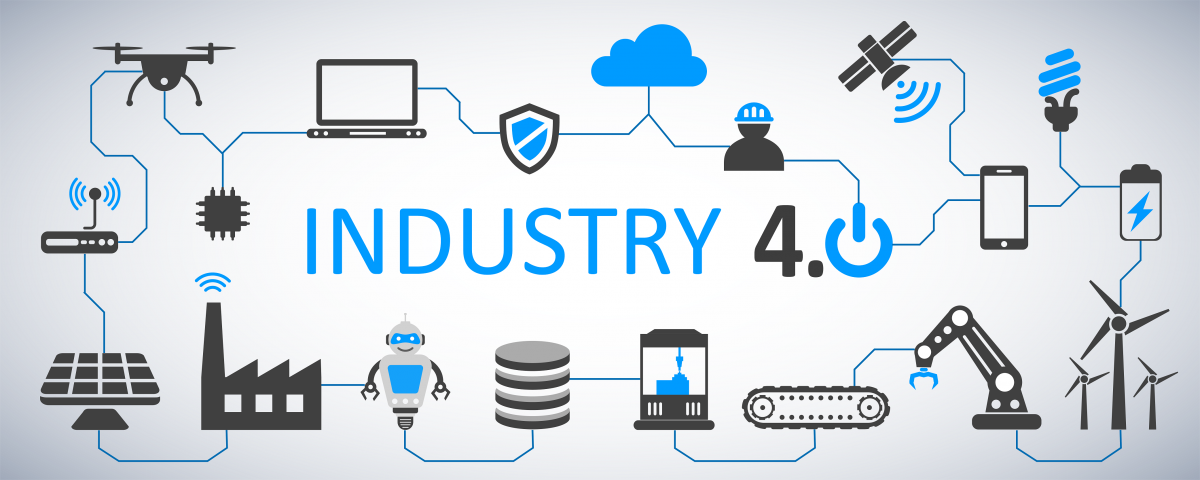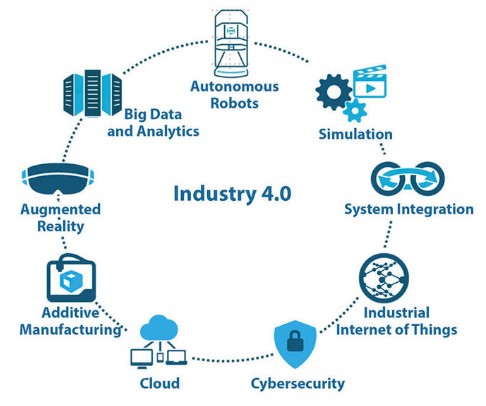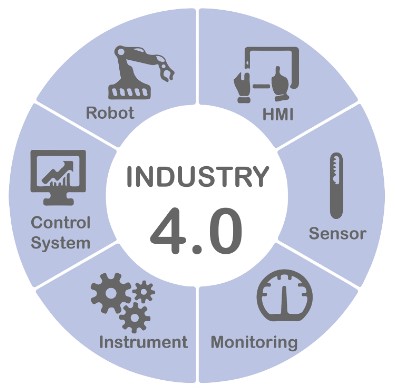Industry 4.0
2021 AUG 27
Mains >
Science and Technology > Miscellaneous > Industry 4.0

WHY IN NEWS?
- Industry 4.0 has started making inroads in Indian manufacturing, real estate, education and other sectors and is seeing a steep adoption, with the COVID-19 pandemic further accelerating the digitization process by at least a decade.
WHAT IS INDUSTRY 4.0?
- Fourth Industrial Revolution, also known as Industry 4.0, is the information-intensive transformation of manufacturing and related industries into smart factories.
- The term ‘Industry 4.0’ was coined by the German government in 2011.
- It involves the integration of some of the key emerging technologies:
- Cyber-Physical Systems:
- Cyber Physical System (CPS) refers to a platform comprising of a mechanical system that is controlled by computer algorithms, and tightly integrated with Internet and to its networked users.
- Internet of Things (IoT):
- The internetworking of physical devices like vehicles, appliances, and buildings using embedded electronics, sensors and software to enable data collection and sharing across physical devices.
- Cloud Computing:
- Internet-based computing through cloud servers provides shared computer processing resources and data on demand.
- Cognitive computing:
- Cognitive computing closely mimics the human thought process within a computerized model. It use technologies like Artificial intelligence, machine learning and big data analytics.
- Additive manufacturing:
- Popularly known as 3D printing, Additive Manufacturing (AM) is defined as the technology that constructs a three-dimensional object from a digital 3D model by adding material layer by layer.

- India’s diversity, demographic potential, fast growing market size and digital infrastructure have the potential to make India a global leader in IR 4.0
FOUR DESIGN PRINCIPLES INTEGRAL TO INDUSTRY 4.0:
- Interconnection:
- The ability of devices and people to connect and communicate with each other through the Internet of things.
- Information transparency:
- Sharing the immense amounts of data and information among the components, so as to instantly adjust and optimize for higher efficiency.
- Technical assistance:
- Ability of the system to assist humans in decision-making, problem-solving, and helping humans with difficult or unsafe tasks.
- Decentralized decisions:
- Ability of cyber physical systems to make decisions on their own and to perform their tasks as autonomously as possible.

EVOLUTION OF INDUSTRIAL REVOLUTION:
- Industry 1.0
- The first industrial revolution (popularly called Industry 1.0) commenced in the 18th century with the use of steam generated power and mechanization of production.
- This was an important transition from manual labour based industry to the use of steam powered engines to increase human productivity.
- Textile industry was one of the early beneficiaries of this mechanization, with the steam engine powered weaving looms replacing the traditional handmade textile products for mass production.
- Industry 2.0
- A century later, the Second Industrial Revolution (Industry 2.0) began with advent of electricity and the assembly line production using the conveyor belts. The tipping point for the industry was when Henry Ford utilized the assembly line concept for mass production in automobile manufacturing
- Industry 3.0
- It was marked with innovation in the electronics world, when the memory-programmable controls and computers came into existence in the later part of 20th Century.
- The digital process automation enabled working of machines in a production process without human intervention
- Industry 4.0
- The fourth industrial revolution, Industry 4.0 was triggered by the hi-tech innovations which brought the cyber physical systems together i.e. smart machines capable of exchanging real time information over the industrial internet of things (IIOT) for decision making process.
- Industry 4.0 is different from the other three in the following aspects:
- It is characterized by a fusion of technologies that is blurring the lines between the physical, digital, and biological spheres.
- It is evolving at an exponential rather and is disrupting almost every industry in every country, not just manufacturing.
BENEFITS OF INDUSTRIAL REVOLUTION 4.0:
- Enhance productivity:
- Industry 4.0 technologies enable can lead to optimum resource allocation, reduce downtime and improve production rates, which makes the manufacturing processes more cost-effective and efficient.
- Knowledge Sharing and Collaborative Working:
- Industry 4.0 technologies allow your production lines, business processes, and departments to communicate regardless of location, time zone, platform, or any other factor. Hence, it will facilitate smoother integration of India into the global supply chain.
- Employment generation:
- Though the fear of job loss due to Industry 4.0 is widespread, various researches pointing out that is baseless.
- The Future of Jobs Report 2018 by World Economic Forum (WEF) predicts the loss of 75 million employments by 2022 worldwide, and the production of 133 million occupations over a similar period.
- Sustainable energy:
- While biotechnology can create more efficient sources of green energy like 4th generation biofuels, smart energy systems can ensure efficient utilization of these resources.
- Poverty alleviation:
- IR 4.0 has the potential to raise human productivity and thereby income. This can prove to be a game changer in poverty alleviation.
- In defense and security:
- IR 4.0 can greatly reduce human casualties and reduce defense expenditures, through efficient military logistics and operations, AI based intelligence analysis, bomb-disposing robots, surveillance and attack drones and other unmanned vehicles.
- In agriculture:
- AI based crop monitoring systems can help predict the output, thus helping in better policy formulation. In fact, drone based systems are already part of assessment in Fasal Bima Yojana.
- In urban development:
- AI, coupled with self-driving cars and automated signaling systems, can ensure smoother traffic in the highly congested Indian cities. Also, Augmented Reality can create a new dimension in planned development of urban areas.
- In manufacturing & business:
- Faster communication and cheaper production technologies can ensure smoother integration of India into the global supply chain. India’s automotive manufacturing sector is a leading user of IR 4.0 technologies.
- In social sector:
- With AI and 5G technologies, healthcare and education services can go global, become more efficient and improve accessibility. These factors can reduce cost and improve quality of these sectors in the country.
- Initiatives like Atal Innovation Mission are already incorporating cutting edge technologies into the school atmosphere.
- Better governance:
- Access to real time quality data can help make governance more target-oriented and delivery of services more effective.
- Eg: Microsoft’s Digital Governance Tech Tour was a National program to deliver critical AI and intelligent cloud computing skills to the Government officials in charge of IT across the country.
CHALLENGES:
- Cyber-security:
- In IR 4.0, People, products and equipment will be increasingly connected to the internet. Although this gives us greater access to data via the cloud, it opens up opportunities for hackers to access networks.
- Need for Highly Skilled Labor:
- India is home to one of the world’s youngest populations. By 2050, India is expected to account for over 18% of the global working age population. Over 100 million newcomers are expected to enter the workforce by 2022.
- Manufacturing, and industry as a whole, continues to rely on humans to enable production. However, with the move to digitally connected systems, there is a greater need for highly skilled labor, which may unintentionally reduce the need for low-skill labor.
- Industry and Market Disruption:
- With new technologies available, existing solutions will eventually be phased out. Similar to the Blockbusters of the world, certain industries will be unable to survive what Industry 4.0 brings to market.
- Rise in inequalities:
- With this revolution it is possible that in the future, talent, more than capital, will represent the critical factor of production.
- This will give rise to a job market increasingly segregated into low-skill/low-pay and high-skill/high-pay segments, which in turn will lead to an increase in social tensions.
- In India, where digital literacy is dismal, a revolution of this sort can lead to sharp rise in inequalities.
- Deficit in Infrastructure & Connectivity:
- Besides digital infrastructure, the country lacks some basic infrastructure such as 24x7 power, high speed internet (especially in rural areas) and workforce with the necessary skill set.
- Quality of data:
- Due to lack of established data collection standards and a large informal sector, India is unreliable when it comes to quality of data collected
- Limited focus on Research and development:
- Though India has emerged as the choice location for cutting-edge Research and Development (R&D) projects for global companies, the overall spending on it remains dismal
- While investment in R&D has shown a consistent increasing trend over the years, as a fraction of India's GDP, it has remained constant at around 0.6% to 0.7% of GDP
- Lack of Innovative atmosphere:
- The present education system heavily stresses on rote learning, examinations and few career choices, all of which inhibits the growth of an innovative environment.
- Challenges faced by MSMEs in adopting Industry 4.0.
- MSMEs lack awareness regarding Industry 4.0 and its benefits.
- They consider such technologies disruptive and having the potential to demolish their existing system.
INITIATIVES:
- Smart Advanced Manufacturing and Rapid Transformation Hub (SAMARTH):
- SAMARTH Udyog Bharat 4.0 is an Industry 4.0 initiative of Department of Heavy Industry, Ministry of Heavy Industry & Public Enterprises, under its scheme on Enhancement of Competitiveness in Indian Capital Goods Sector.
- It seeks to facilitate and create eco system for propagation of Industry 4.0 set of technologies in every Indian manufacturing by 2025, be it MNC, large, medium or small scale Indian company.
- Centre of Excellence (CoE) on IT for Industry 4.0:
- This CoE would act as a knowledge centre for entrepreneurs and startups, propagating the concept of IT and its application in IR 4.0.
- National Strategy on Artificial Intelligence:
- Under the strategy, NITI Aayog has adopted a three-pronged approach – undertaking exploratory proof-of-concept AI projects in various areas, crafting a national strategy for building a vibrant AI ecosystem in India and collaborating with various experts and stakeholders.
- Centre for Fourth Industrial Revolution:
- World Economic Forum (WEF) has partnered with the Indian government to set up the Centre for the Fourth Industrial Revolution India in Mumbai.
- It is the fourth in the world after San Francisco, Tokyo and Beijing.
- It will work in collaboration with NITI Aayog in India to co-design new policies and protocols for emerging technologies. Initial focus of India will be on Artificial Intelligence, Blockchain and drones.
- National Mission on Interdisciplinary Cyber-Physical Systems (NM-ICPS):
- The Mission addresses the ever increasing technological requirements of the society, and takes into account the international trends and road maps of leading countries for the next generation technologies.
- It would address technology development, application development, human resource development and skill enhancement, entrepreneurship and start-up development in CPS and associated technologies.
- National Manufacturing Policy, 2017:
- Government rolled out a new policy to push the manufacturing share to 25 percent of the GDP by consolidating Make in India initiative, with focus on adoption of digital platforms for IR 4.0.
WAY FORWARD:
- Policy support:
- India should have a robust policy in place.
- It should have long term developmental plans, robust institutional frameworks, involve all stakeholders (such as the private players, start-ups and tech providers, academia, regulators etc.) and foster development of necessary infrastructure in the country.
- Human resource development:
- Government should give added focus on initiatives to develop relevant skills, technical and vocational training programmers, innovative approaches to industrial training, and enhanced public-private collaboration.
- Security:
- Adequate protection measures must be ensured to ensure that the people’s rights and country’s security is safeguarded.
- For the same, India must speed up its process of finalizing privacy laws and data protection laws.
- Special emphasis on upskilling:
- Talent within the labour force needs to be reskilled to keep up with the pace of IR 4.0. This can be done through workshops on skill enhancement, on-job training etc.
- Research and Development:
- India needs to promote the collection of quality real-time data and encourage its investments in research and development into cutting edge areas like AI and machine learning.
PRACTICE QUESTION:
Q. What do you mean by Industry 4.0? Analyze the reforms required in Indian manufacturing sector to keep up with the pace of Industry 4.0?


